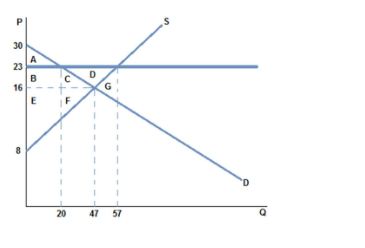Which of the following describes the impact of unions on wages?
a. The high wages negotiated by the union drive up wages in the nonunion sector by
extension.
b. Collective bargaining has the effect of lowering wages in general to keep more
people employed.
c. By restricting membership, the union drives up union wages and drives down
nonunion wages.
d. The union has the collective power to enforce equilibrium wages for everyone.
c. By restricting membership, the union drives up union wages and drives down
nonunion wages.
You might also like to view...
If a non-binding price floor were to be set in the market in the graph shown, it could be set at:

A. $30.
B. $23.
C. $16.
D. All of these would be binding price floors for this market.
Refer to the above graph with three demand curves. An "increase in quantity demanded" would be illustrated by a change from:
Point 5 to point 1 Point 2 to point 5 Point 4 to point 6 Point 4 to point 1
If the price of "X" increases and you buy more "Y," then
A. "X" and "Y" are complements, and the price of "Y" will increase. B. "X" and "Y" are substitutes, and the price of "Y" will increase. C. "X" and "Y" are substitutes, and the price of "Y" will decrease. D. "X" and "Y" are complements, and the price of "Y" will decrease.
Refer to the information provided in Table 36.2 below to answer the question(s) that follow. Table 36.2 PointAggregate Income (Y)Aggregate Consumption (C) A 10 14 B 20 23 C 30 25 D 40 26 E 50 34 F 60 39The data in the table was used to estimate the following consumption function: C = 12 + 0.4YRefer to Table 36.2. The error for point F is equal to
A. -6. B. -3. C. -1. D. +2.